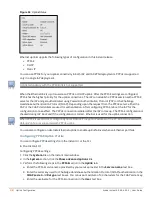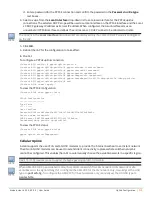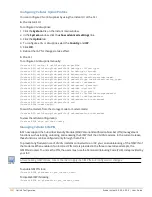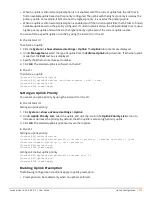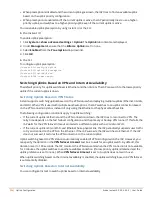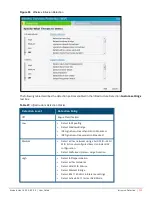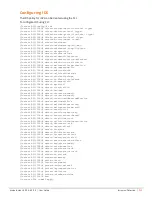
318
| Uplink Configuration
Aruba Instant 6.5.0.0-4.3.0.0 | User Guide
Figure 94
Uplink Status
Ethernet uplink supports the following types of configuration in this Instant release.
n
PPPoE
n
DHCP
n
Static IP
You can use PPPoE for your uplink connectivity in both IAP and IAP-VPN deployments. PPPoE is supported
only in a single IAP deployment.
Uplink redundancy with the PPPoE link is not supported.
When the Ethernet link is up, it is used as a PPPoE or DHCP uplink. After the PPPoE settings are configured,
PPPoE has the highest priority for the uplink connections. The IAP can establish a PPPoE session with a PPPoE
server at the ISP and get authenticated using Password Authentication Protocol (PAP) or the Challenge
Handshake Authentication Protocol (CHAP). Depending upon the request from the PPPoE server, either the
PAP or the CHAP credentials are used for authentication. After configuring PPPoE, reboot the IAP for the
configuration to take effect. The PPPoE connection is dialed after the IAP comes up. The PPPoE configuration is
checked during IAP boot and if the configuration is correct, Ethernet is used for the uplink connection.
When PPPoE is used, do not configure Dynamic RADIUS Proxy and IP address of the VC. An SSID created with
default VLAN is not supported with PPPoE uplink.
You can also configure an alternate Ethernet uplink to enable uplink failover when an Ethernet port fails.
Configuring PPPoE Uplink Profile
You can configure PPPoE settings from the Instant UI or the CLI.
In the Instant UI
Configuring PPPoE settings:
1. Click the
System
link on the Instant main window.
2. In the
System
section, click the
Show advanced options
link.
3. Perform the following steps in the
PPPoE
section in the
Uplink
tab:
a. Enter the PPPoE service name provided by your service provider in the
Service name
text box.
b. Enter the secret key used for Challenge Handshake Authentication Protocol (CHAP) authentication in the
CHAP secret
and
Retype
text boxes. You can use a maximum of 34 characters for the CHAP secret key.
c. Enter the username for the PPPoE connection in the
User
text box.















